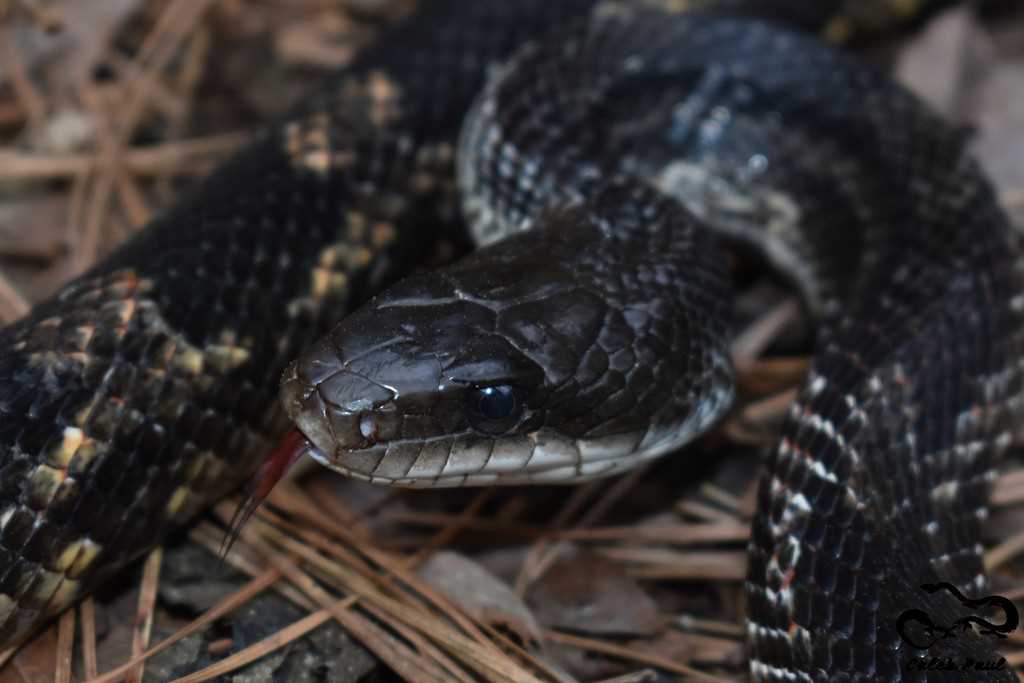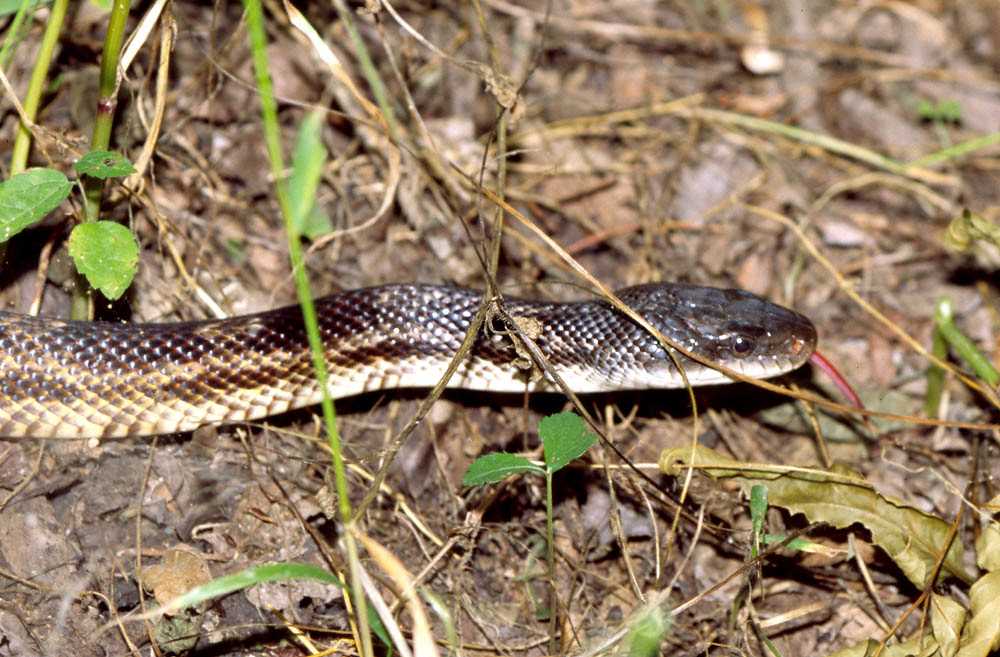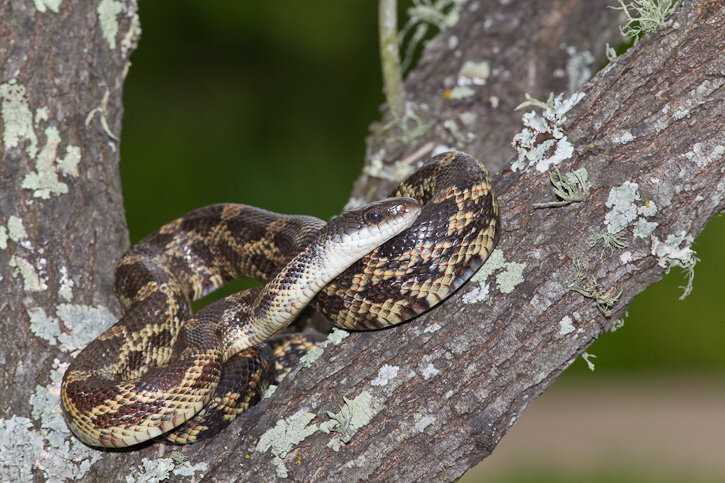
The East Texas Rat Snake is a fascinating species of snake that can be found in the eastern region of Texas. As its name suggests, it is commonly known for its ability to hunt and feed on rats, making it an important predator in the local ecosystem. This snake has a distinctive appearance, with its vibrant colors and slender body, which helps it to blend in with its surroundings.
Characterized by its shiny scales, the East Texas Rat Snake can grow to an average length of 3 to 5 feet, with some individuals reaching up to 7 feet. It has a slender body that allows it to easily navigate through tight spaces while hunting for prey. This snake typically has a yellowish-brown color with dark brown or black markings along its body, giving it a beautiful and unique pattern.
In terms of behavior, the East Texas Rat Snake is an excellent climber and swimmer. It is primarily diurnal, meaning it is most active during the day, although it can also be active at dusk and dawn. This snake is known to be docile and non-venomous, making it relatively harmless to humans. However, if threatened, it may try to defend itself by biting or releasing a musky odor as a warning sign.
The East Texas Rat Snake can be found in a variety of habitats, including forests, woodlands, grasslands, and even near human settlements such as farms and gardens. It prefers areas with a good amount of vegetation and access to water sources, as it relies on both for hunting and survival. This species is known for its adaptability and can even tolerate some level of urbanization.
Physical Characteristics of the East Texas Rat Snake
The Rat Snake can grow to be quite large, with adults reaching lengths of up to 6 to 7 feet. They have a slender body, with keeled scales that give them a rough texture. Their coloration can vary, but they are typically light brown or gray with dark brown or black blotches. This coloration helps them blend into their surroundings and provides camouflage.
One of the most distinctive features of the Rat Snake is its head. It has a triangular-shaped head that is larger than its neck, and it has round pupils. It also has a slender, pointed tail that is often used for climbing trees.
Another interesting characteristic of the Rat Snake is its ability to flatten its body when threatened. This makes it appear larger and can be intimidating to potential predators. Additionally, when threatened, the Rat Snake will often vibrate its tail, mimicking the rattle of a rattlesnake. This behavior serves to scare away predators.
Overall, the physical characteristics of the East Texas Rat Snake make it a unique and fascinating species. Its adaptability, camouflage, and defensive behaviors ensure its survival in the diverse habitats it inhabits.
Habitat of the East Texas Rat Snake

One of the preferred habitats of the East Texas Rat Snake is woodland areas. It can be found in both mixed forests and pine forests, where it utilizes the trees for climbing and basking. The snake is also known to inhabit swampy areas and marshes, where it can hunt for its prey and find shelter.
This snake species is highly adaptable and can also be found in urban areas, such as parks, gardens, and even backyards. It is tolerant of human disturbance and can thrive in both natural and human-altered habitats.
When choosing a habitat, the East Texas Rat Snake prefers areas with abundant vegetation and access to water sources, such as rivers, streams, and ponds. These water sources are essential for the snake’s survival, as it needs to drink and may also use them to cool off during hot weather.
Furthermore, this snake species can be found at various elevations, from sea level up to around 1,500 feet (457 meters). It has adapted to different climatic conditions, including hot summers and mild winters, making it well-suited for the diverse habitats found in East Texas.
Diet and Hunting
The East Texas Rat Snake is a non-venomous snake native to the eastern part of the state of Texas. It is known for its adaptability and wide ranging diet.
Being a constrictor, the East Texas Rat Snake captures its prey by coiling its body around it and squeezing until the prey suffocates. Its diet consists primarily of rodents, such as rats and mice, but it will also eat birds, eggs, lizards, and other small animals that it can overpower.
The snake is an opportunistic hunter and will scavenge for carrion if necessary. It has been observed hunting both on the ground and in trees, where it can climb and maneuver with ease. This adaptability allows it to take advantage of different habitats and food sources.
When hunting, the East Texas Rat Snake relies on its excellent sense of smell and vision to locate its prey. It will patiently wait for its target to come within striking distance before launching a quick and precise attack. Its strong jaws and teeth enable it to grip and constrict its prey effectively.
After capturing its prey, the snake will swallow it whole, using its flexible jaw to stretch open its mouth and allow for the ingestion of larger prey items. The digestion process can take several days, during which the snake may remain sedentary and hide away to protect itself from potential threats.
Reproduction of the East Texas Rat Snake
Mating Season:
During the spring months, the East Texas Rat Snakes enter their mating season. This period usually spans from April to May, when the temperatures rise, and the snakes become more active. Males actively search for potential mates and engage in combat with competing males to win the attention of the females.
Courtship and Mating:
Once a male successfully court a female, they perform an intricate courtship dance. This dance involves intertwining their bodies, flicking their tongues, and rubbing against each other. The male rat snakes often produce a vibrating sound by rapidly shaking their tails against dry leaves or vegetation, which seems to be a display of sexual prowess.
Once courtship is completed, the male zigzags his body along the ground until the female follows, and then they mate. The mating process can last several hours, during which the male inserts one of his hemipenes into the female’s cloaca.
Egg Laying and Incubation:
After mating, the female will spend several weeks digesting and preparing her body for egg production. Between May and July, she will lay between 6 to 24 eggs in a secure location, such as rotting logs, tree stumps, or underground burrows. The eggs are usually laid in a communal nest, where multiple females deposit their eggs together.
Hatching and Juvenile Stage:
When the eggs hatch, the baby rat snakes emerge, measuring around 30 to 40 centimeters in length. These hatchlings are independent from birth and must fend for themselves. They are capable of hunting and capturing small prey items, such as lizards and rodents. The juveniles will grow rapidly in their first few years of life.
Behavior
The East Texas rat snake is an efficient predator, often hunting for rodents such as rats, mice, and small birds. It will constrict its prey, suffocating it before swallowing it whole. This snake also has a keen sense of smell and can detect its prey by flicking its tongue and picking up scent particles in the air.
During the breeding season, which typically occurs in the spring, male East Texas rat snakes will engage in combat with each other to win the attention of a female. This combat involves intertwining their bodies and pushing against each other in an attempt to establish dominance. The victorious male will then mate with the female, and she will lay a clutch of eggs in a warm, secluded location.
When threatened, the East Texas rat snake will often try to escape rather than confront its aggressor. If escape is not an option, it may mimic the behavior of a venomous snake by hissing loudly, flattening its head, and striking, although it lacks venom. This display is usually enough to deter predators, and the snake will escape to safety.
In general, the East Texas rat snake is a solitary creature, preferring to spend its time alone. However, during the winter months, it may hibernate in communal dens with other snakes of its species. This behavior helps the snakes conserve body heat and survive the colder temperatures.
Threats and Predators
Another threat to the East Texas Rat Snake comes from invasive species. Non-native predators such as cats and dogs can pose a serious threat to these snakes by preying on them or disturbing their nests. This can negatively impact their population and reproductive success.
Human activities also contribute to the decline of this snake species. Illegal collection and trade of these snakes as pets is a major issue. Many individuals are captured from the wild and sold in the exotic pet trade. This not only disrupts the natural population but also poses a threat to the survival of these snakes in the long term.
Predators

Conservation Efforts
Efforts are being made to conserve the East Texas Rat Snake and its habitat. Protected areas have been established where these snakes can thrive without the threat of habitat destruction and illegal collection. Awareness programs are also conducted to educate the public about the importance of preserving the natural habitat of these snakes and the need to avoid disturbing them.
It is crucial to protect the East Texas Rat Snake as it is not only a part of the Texas ecosystem, but it also plays a significant role in maintaining the balance of the food chain. By conserving their habitat and raising awareness about their importance, we can ensure the survival of this snake species for future generations to enjoy.
Conservation Status
The East Texas Rat Snake is found primarily in the southeastern region of the United States, including the eastern parts of Texas, as well as parts of Louisiana, Arkansas, and Oklahoma. The snake is well adapted to a variety of habitat types, including forests, swamps, and grasslands.
Through effective conservation measures, such as habitat protection and public awareness campaigns, the population of East Texas Rat Snakes has remained stable. The species is not currently listed under any specific conservation programs or initiatives.
Conservation Measures
Conservation measures for the East Texas Rat Snake include:
- Preserving and protecting its natural habitat.
- Implementing land use practices that minimize habitat destruction and fragmentation.
- Supporting public education and awareness programs to promote the importance of snake conservation.
- Encouraging responsible pet ownership and discouraging illegal wildlife trade.
- Collaborating with local communities, landowners, and stakeholders to conserve snake habitats and promote coexistence.
- Providing adequate protection through legislation and enforcement against illegal hunting and collection of East Texas Rat Snakes.
Conclusion
The East Texas Rat Snake, with its unique characteristics and vital ecological role, is an important species in the southeastern United States. While its conservation status is currently classified as least concern, sustained efforts are necessary to preserve its habitats and prevent potential threats.
By implementing effective conservation measures and fostering public awareness, we can ensure the long-term survival of this fascinating snake species and maintain the ecological balance of its natural habitats.
Interesting Facts about the East Texas Rat Snake
1. Color Variation
The East Texas Rat Snake displays a wide range of color variations, including grey, tan, brown, black, and various shades of red. Some individuals may have a pattern of blotches or stripes along their bodies, while others may have a solid color.
2. Impressive Size
This snake species can reach an impressive size, with adults growing up to 6 feet long on average. Some individuals have even been recorded to exceed this length. The East Texas Rat Snake is known for its slender and elongated body shape, allowing it to maneuver through various habitats with ease.
3. Excellent Climbers
4. Varied Diet
This snake species is an opportunistic predator and has a varied diet. It primarily feeds on small mammals such as rats, mice, and squirrels, but may also consume birds, eggs, lizards, and other snakes. The East Texas Rat Snake is known for its ability to overpower and suffocate its prey by constriction.
5. Important Role
The East Texas Rat Snake plays an important role in its ecosystem as a predator that helps control the population of rodents. By feeding on small mammals, this snake species assists in maintaining a balance in the ecosystem and can be considered beneficial to humans as well.
6. Defensive Behavior
When threatened, the East Texas Rat Snake will exhibit defensive behavior to protect itself. It may coil its body, emit a loud hissing sound, and strike if necessary. However, despite its intimidating behavior, this snake species is generally non-aggressive towards humans and will try to flee when encountered.

I’m Lena Adams—a product of an unconventional upbringing in the African wilderness. My father, a daring explorer of African wildlife, sparked my fascination with reptiles, a passion that intertwined with the tragic loss of my mother during an expedition, leaving an indelible mark on my life. Driven to understand the creatures that captivated my parents, I embarked on my journey, sharing insights about reptiles, frogs, and lizards on my website. Through my explorations and conservation efforts, I honour my family’s legacy while seeking connections—to the creatures, nature, and the mother whose presence I yearn to understand.
